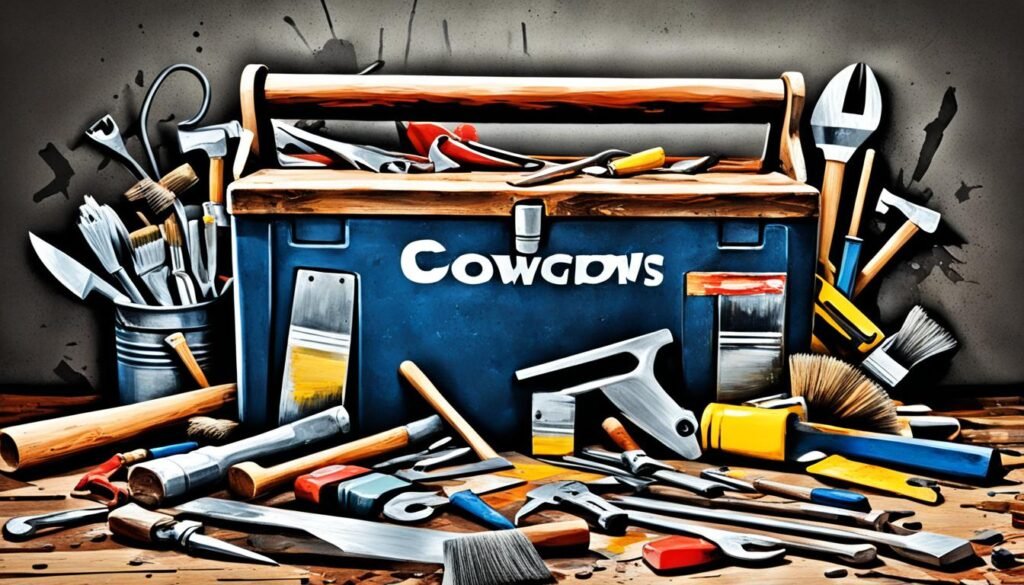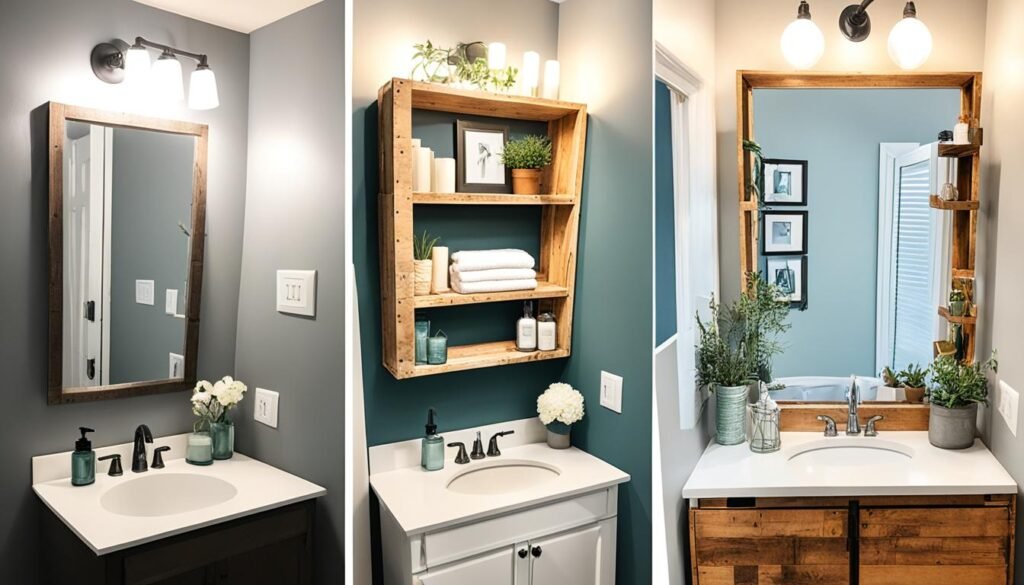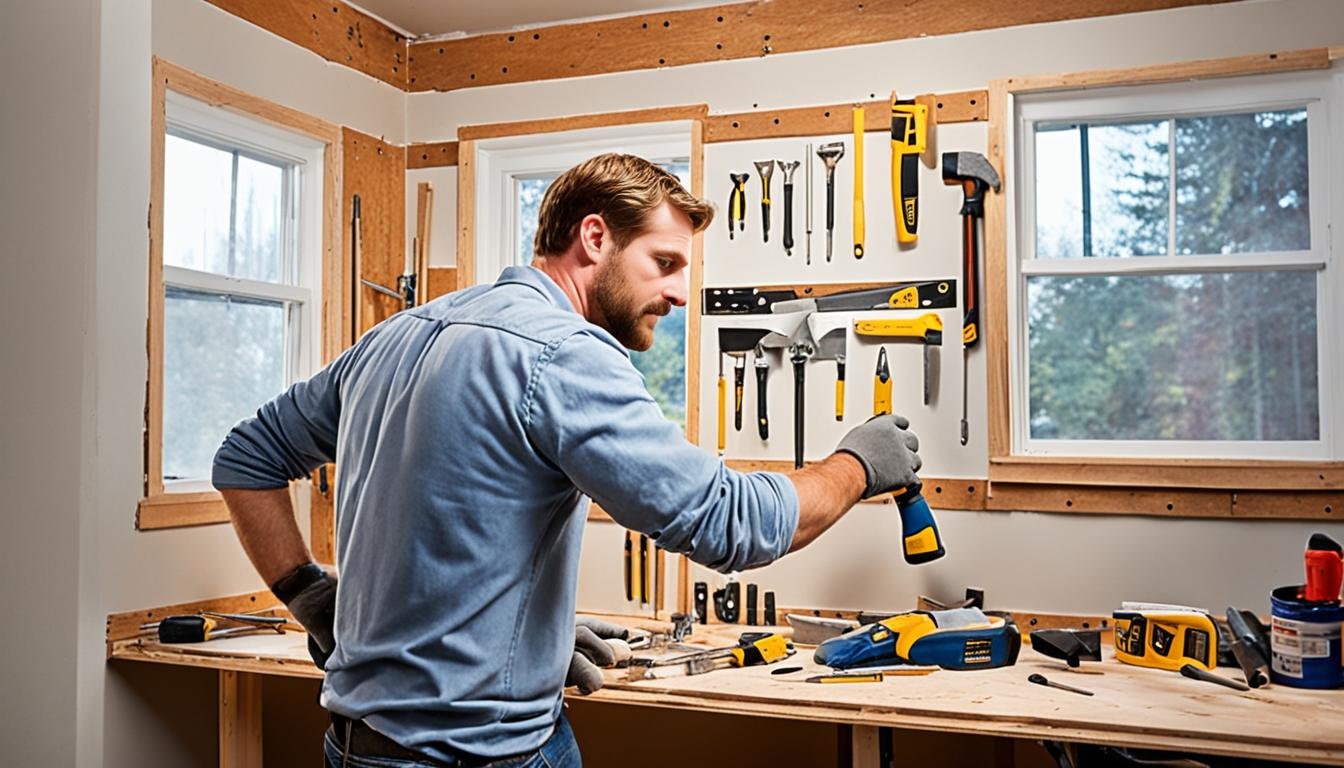These days are hard. We’re all worried about our money because of the shaky economy. Feeling lost and powerless during a recession is common. But there’s a way out. You can find hope, pride, and maybe even make some money.
Let’s dive into DIY home improvement. This story will show how taking control with budget-friendly DIY projects can fight off recession blues. Plus, boost your home’s worth. So, it’s time to pick up your tools and get creative!
Key Takeaways:
- DIY home improvement projects can be a powerful tool to combat recession and enhance the value of your home.
- By renovating during an economic downturn, you can take advantage of lower competition and potential savings on materials and labor.
- Boosting curb appeal, revamping high ROI spaces, and creating a self-sufficient home are just a few of the tactics you can employ.
- Engaging in DIY projects provides psychological benefits, such as a sense of accomplishment, stress relief, and increased self-confidence.
- Long-term planning is crucial, and strategic timing and calculating savings from energy-efficient upgrades can maximize your efforts.
Understanding the Current Economic Climate and Home Renovation Trends
Today’s economy has everyone talking about a possible recession. Many homeowners are worried about its effect on the housing market and renovation trends. While debates about a recession continue, it’s important to look at the effects and the benefits of renovating now.
Examining the Recession Debate and Housing Market Impact
The debate about a recession has made people unsure about the economy’s future. Even without a firm answer, fears of a recession are affecting the housing market and renovation industry. When the economy seems unstable, people might think twice before buying a home or starting big renovations.
This worry means fewer people are competing in the housing market, possibly dropping home prices. For those thinking about renovations, this could be a chance to improve their homes for less money. With fewer buyers, homeowners might get better deals from contractors and on materials.
The Upside of Renovating During an Economic Downturn
Renovating during hard economic times has its perks for homeowners. It’s a chance to better their living spaces and add value to their homes. Making upgrades during a downturn could mean more profit later when the market gets better.
Also, with fewer renovations happening, finding a contractor might be easier. You might also get to negotiate lower prices. Suppliers might even offer discounts to encourage spending.
Another upside is saving on future costs. Energy-saving renovations can reduce bills and help the environment. They might also bring tax credits and other incentives. These savings show why renovating now could be a smart move for the future.
| Current Economic Climate | Recession | Housing Market Impact | Renovating During Economic Downturn |
|---|---|---|---|
| Uncertain | Ongoing debate | Potential decline in home prices | Opportunity to add value at a lower cost |
| Less competition in the market | Potential savings on materials and labor | Potential to negotiate better deals | Increase home value for future profit |
| Availability of contractors and materials | Potential discounts from suppliers | Long-term cost savings with energy-efficient upgrades | Lower utility bills |
Tactical DIY Projects to Enhance Home Value Amidst Recession
Enhancing your home’s value during a recession is possible with DIY projects. These projects are affordable and add both value and charm. We’ll look at some easy DIY projects that can help raise your home’s value, even when times are tough.
Boosting Curb Appeal on a Budget
Improving your home’s curb appeal is a simple way to boost its value. The exterior is what people first notice. You don’t need a lot of money for a great curb appeal. Here are some cost-effective DIY projects:
- Landscaping: A neat garden lifts your home’s look. Add colorful flowers, trim bushes, and use fresh mulch or stones.
- Painting the Exterior: New paint can greatly improve your home’s look. Choose a fitting neighborhood color and brighten your front door for appeal.
- Updating the Front Door: A new or revamped front door makes your home welcoming. Use new paint and hardware for a fresh look.
Small projects can hugely transform your home’s front. They not only raise your home’s value but also attract attention. Boosting your curb appeal sets a welcoming tone for your home.
Revamping Spaces with High ROI Potential
Some areas in your home can offer a bigger return on investment (ROI). Focus on these areas for upgrades that enhance daily life and add value. Consider improving these areas:
| Kitchen | Bathroom | Outdoor Living Areas |
|---|---|---|
| Updating cabinetry, countertops, and fixtures | Replacing old tiles, updating fixtures, and adding storage | Adding a patio, better landscaping, and outdoor seating |
| Improving lighting and adding efficient appliances | Getting a new vanity, better ventilation, and a modern shower | Building a deck or pergola, outdoor lighting, and an entertainment space |
Targeting these high ROI areas can lead to significant value boosts. They are key parts of the home and influence buying decisions. They’re worth the investment, even in a recession.
Understanding these tactical DIY projects can guide your home improvements during a recession. Focusing on curb appeal and high ROI areas not only increases value. It also makes your home a better place to live.
How to Fight Recession by Doing Home Improvement Yourself
The economy might feel shaky, making us wonder if a recession is coming. But we can take control by starting DIY home improvement projects. This approach helps us save money and learn new skills. It also gives us a sense of empowerment.
DIY projects are great during tough economic times because they save money. Professional home improvements can get pricey. Taking on projects yourself cuts labor costs. You also get to pick materials that are kind on your wallet.
Here are some tips to succeed in DIY home improvements:
- Start with small projects to slowly build your skills and confidence.
- Do your homework. Look up tutorials, read guides, and talk to experts to understand the project fully.
- Buy quality tools and materials. They last longer and work better, making the process smoother.
- Always put safety first. Wear the right gear, and use the correct tools and techniques.
- If a project feels too big, don’t be afraid to get help. Recognize when you need an expert’s advice.
Following these tips will help you tackle various projects, like painting and making furniture. The joy of finishing these projects yourself is very rewarding.
“DIY home improvements are a smart way to beat recession. They let people take command of their home’s look while learning and saving. It’s a chance to craft a personal, cost-effective space.” – Expert Home Improver
If you want to beat recession and improve your home on a budget, DIY is a smart choice. With some planning and effort, DIY projects can really make a difference. You’ll end up with a home that’s not just more valuable, but also truly yours.
Navigating Home Improvement Costs During Economic Recession Solutions
Work on your home improvement projects needs careful budgeting, especially in uncertain economic times. In this section, we’ll look at some ways to manage your costs and make your money go further during an economic downturn.
Finding Bargains on Materials and Tools
Looking for deals on materials and tools is a smart way to save money. Here are some suggestions for snagging the best bargains:
- Watch for sales and discounts at local home improvement stores.
- Think about buying second-hand, like slightly used appliances or furniture, to save money.
- Talk to suppliers about lowering prices or offering discounts, especially on large purchases.
With some effort to find deals and make smart choices, you can cut costs without giving up quality.
Planning Your DIY Renovation to Maximize Savings
Smart planning is also key to saving money on a DIY renovation. Here’s how to plan more effectively:
- Make a detailed budget to control your spending and avoid unnecessary expenses.
- Break your renovation into smaller projects. This way, you can manage costs better by tackling one area at a time.
- Do your homework and compare prices to ensure you’re getting good deals.
- Look at doing some tasks yourself, like painting or installing fixtures, to save on labor.
- Try to plan your work around seasonal sales and when contractors might offer better rates.
Good planning lets you stretch your budget and save more on your projects.

Managing home improvement costs in a tight economy takes planning and a savvy approach. By hunting for bargains and strategically planning your DIY projects, you can increase your savings. This way, you can reach your home improvement goals without overspending.
Creating a Self-Sufficient Home with Sustainable DIY Upgrades
In uncertain economic times, many homeowners seek self-sufficient ways to lessen their reliance on outside resources. By adopting sustainable DIY projects, people can save money and live more eco-friendly. Here are some upgrades to make your home self-sufficient:
- Installing Solar Panels: Use the sun’s power for renewable energy. Solar panels can cut electric bills and lower your environmental impact. Thanks to federal tax incentives and DIY kits, adding solar panels is now affordable for homeowners.
- Implementing Rainwater Harvesting Systems: Saving rainwater for your garden is a smart way to use less water and save money. You can start with a simple rain barrel or install a system to capture and filter rainwater for home use. This upgrade lets you use natural resources wisely and eases pressure on city water supplies.
- Embracing Energy-Saving Measures: Making your home energy-efficient can be as easy as adding LED lights, programmable thermostats, and energy-saving appliances. These changes can reduce your energy use and save you money over time.
- Creating a Home Garden: Grow your own fruits, veggies, and herbs. It doesn’t matter if you have a tiny balcony or a big backyard. This step towards self-sufficiency gives you fresh, organic food and cuts down on grocery shopping. Also, turning kitchen and garden waste into compost makes your garden even better.
These sustainable DIY projects let homeowners manage their energy use and cut down on pollution. Taking on these projects saves you money and supports an eco-friendly, self-reliant lifestyle.
Practical Tips for Budget-Friendly Home Renovations
Looking to renovate your home without spending a lot? There are plenty of smart ways to do this. You can change your home’s look or increase its value on a budget. These affordable ideas will have a big effect without costing too much.
Upcycling and Repurposing Materials for Home Decor
One cheap way to update your home is by upcycling and repurposing things. Instead of buying new, try making old items look new again. You could turn old pallets into cool furniture, or use mason jars as stylish lights. Even vintage doors can become special wall art.
Shopping at thrift stores, flea markets, or yard sales can also save you money. You might find some great deals. With creativity and DIY skills, you can make second-hand finds into stunning home decor.
Refinishing or painting existing furniture can also cut costs. A new coat of paint can make old furniture look brand new. This is a good way to update your home’s look for less.
DIY Networks and Communities for Skill Exchange
Joining DIY communities can offer valuable help and skill sharing. These groups are filled with DIY enthusiasts eager to share their knowledge. It’s a great way to learn and find help with your projects.
Connecting with experienced individuals can teach you new techniques. You can get project advice or find friends for bigger projects. This exchange builds your confidence and broadens your skills.
Online platforms like Reddit, Pinterest, and Facebook groups are full of tips and ideas. Don’t hesitate to join in. Ask questions and share what you know. The DIY community thrives on mutual support and learning.
From using old materials creatively to joining DIY groups, these tips will help you renovate your home affordably. With some imagination and effort, you can beautifully transform your space without spending a lot.

The Psychological Benefits of DIY Projects During Tough Economic Times
Working on DIY projects can do more than save money. They also bring lots of mental benefits that help with your well-being. These perks, along with saving money, make DIY a good choice when times are hard.
Starting and finishing a DIY project gives you a big sense of achievement. Making something by yourself and seeing the end product boosts your self-esteem. It gives you pride. This boost is crucial when money is tight or jobs are uncertain.
DIY helps with stress too. Doing something practical takes your mind off money problems. It lowers your anxiety and gives you a break from tough times.
Also, DIY builds your confidence. Learning and mastering new skills proves you can tackle challenges. This empowerment affects your life at work and in personal ways too.
When times are unsure, DIY gives you a positive way to spend your time. You can use your creativity in a constructive way. Controlling a project gives you autonomy. It distracts you from worrying about the economy.
In short, DIY is more than a way to save money when the economy is down. It gives you achievement, stress relief, more confidence, and a useful activity. DIY can help you face hard times with more strength and creativity.
Long-Term Planning: Home Renovation On a Budget
Home renovation on a budget needs careful planning. By thinking ahead and picking the right time for your projects, you can save a lot. Plus, adding energy-efficient updates means more savings and a greener home in the long run.
Timing Your Home Improvement Projects Strategically
Choosing the right time for home improvements is crucial. Planning your renovations for specific seasons can help you catch sales and cheaper materials. For instance, outdoor work like landscaping or painting costs less in the off-season.
It’s also smart to think about the order of your projects. Some need to finish before others can start. This way, you can save time and money, making everything go smoothly.
Remember that some projects might need permits, which could affect your schedule. Always check local rules to keep your renovation on track without hold-ups.
Calculating Long-Term Savings from Energy-Efficient Upgrades
Energy-efficient upgrades can really pay off over time. They lower your bills and are better for the planet. Here are key upgrades to think about:
- Install insulation: Insulating your home keeps it warm in winter and cool in summer, saving a lot of energy.
- Upgrade windows: Energy-saving windows help keep your home temperature steady, which can cut heating and cooling costs.
- Replace outdated appliances: New, efficient fridges, washers, and dishwashers use less power and water, making a big difference.
- Switch to LED lighting: LEDs use less electricity and last longer than old bulbs, saving money right away and over time.
- Implement smart home technology: Smart thermostats and lighting controls automate energy use, making your home more efficient and less wasteful.
Figuring out how much you’ll save with these upgrades can inspire you to include them in your plans. Look at the return on investment and how much you’ll save in the long run to decide what’s best for your renovation.
By planning your renovations and choosing efficient upgrades, you can renovate affordably. This not only saves money now but also supports financial and environmental well-being for the future.
Cost-Effective DIY Renovations that Require Minimal Professional Help
If you want to save money, there are many DIY projects you can do with little help from pros. These efforts not only cut costs but also let you customize your home. Here are a few ideas to begin with:
1. Painting
Painting is one of the simplest yet most impactful DIY tasks. Just a new coat of paint can make any room look fresh and alive. It doesn’t matter if you repaint a whole room or just one wall, painting is a budget-friendly way to refresh your home.
2. Installing a Backsplash
Adding a backsplash can bring style to your kitchen or bathroom. With some research and basic tools, you can put up a beautiful backsplash by yourself. It’s an easy project that makes a big difference in your space.
3. Updating Light Fixtures
Changing light fixtures is another budget-friendly update. Choosing modern, stylish fixtures can change a room’s vibe. There are many affordable choices, from chandeliers to pendant lights, that reflect your style and fit your budget.
“These cost-effective DIY renovations not only save money but also provide a sense of accomplishment and personalization to your home”
Tackling these projects saves you labor costs and brings personal satisfaction. Plus, the improvements you make add value to your home now and later.
| DIY Renovation | Estimated Cost | Estimated Time |
|---|---|---|
| Painting | $50 – $200 (depending on room size) | 1 – 2 days |
| Installing a Backsplash | $200 – $500 (including materials) | 1 – 2 weekends |
| Updating Light Fixtures | $100 – $300 (per fixture) | 1 – 2 hours per fixture |
The costs and time listed above are just rough estimates. They can change based on the project size, material choices, and your experience. Yet, they give a basic idea of what to expect with these DIY renovations.
Remember, the best approach to cost-effective DIY projects is to start simple and slowly take on bigger challenges. With some patience, creativity, and minimal help, you can achieve great results without overspending.
Conclusion
In these uncertain times, it’s key to find ways to combat recession and add home value. DIY home improvement projects are ideal for this. We’ve looked at various tips and solutions for this in the article. These budget-friendly renovations can boost your home’s appeal and value.
Knowing the economy and housing market helps in making smart renovation choices during downturns. There are benefits like low competition and cheaper materials. This means you can add more value to your home while saving money.
Budget-wise DIY projects can uplift your home’s look and value. These range from simple outdoor fixes to major kitchen and bathroom makeovers. The goal is to spend wisely to get the most back.
Strategic planning and hunting for deals are crucial for DIY renovations in a recession. Sustainable upgrades make homes more self-reliant and eco-friendly.
DIY renovations in hard times save money and offer personal benefits. They bring a sense of achievement and lower stress. Joining DIY communities boosts learning and skills.
Long-term planning for budget home renovations is vital. Timing and choosing energy-saving upgrades can lead to big savings. DIY projects that limit the need for pros maximize your investment.
In conclusion, DIY projects are a strong strategy for beating recession and enhancing home value. With the tips and strategies from this article, you can start your DIY projects confidently. So, it’s time to get creative and upgrade your living spaces.
FAQ
How can DIY home improvement projects help individuals fight recession?
What are some budget-friendly home upgrades individuals can do to add value to their homes?
How can individuals find bargains on materials and tools during a recession?
What are some tips for successfully completing DIY home improvement projects?
How can DIY projects during tough economic times provide psychological benefits?
How can individuals time their home improvement projects strategically to maximize savings during a recession?
What are some cost-effective DIY renovations that individuals can do with minimal professional help?
Source Links
- https://astricknation.com/beat-recession-with-home-improvement-tactics/
- https://www.usehatchapp.com/blog/how-can-my-business-thrive-during-a-recession-home-improvement-edition
- https://info.builderfunnel.com/ways-to-recession-proof-remodeling-custom-home-building-business



[…] https://sublimehsolutions.net/beat-recession-with-diy-home-improvement-tips/ […]
[…] https://sublimehsolutions.net/beat-recession-with-diy-home-improvement-tips/ […]
[…] earlier. Brands like HomeRight, Wagner, and Titan offer excellent choices for DIY projects. These best airless paint sprayers for DIY fans have unique features for different needs and […]
[…] these Painting Safety Tips for a safe and healthy painting project at home. Choose low-VOC or water-based paints and keep the area well-ventilated. Always wear protective gear to stay safe. This way, you can make […]